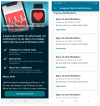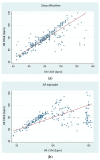Accuracy of a Smartwatch to Assess Heart Rate Monitoring and Atrial Fibrillation in Stroke Patients
- PMID: 37430546
- PMCID: PMC10223397
- DOI: 10.3390/s23104632
Accuracy of a Smartwatch to Assess Heart Rate Monitoring and Atrial Fibrillation in Stroke Patients
Abstract
(1) Background: Consumer smartwatches may be a helpful tool to screen for atrial fibrillation (AF). However, validation studies on older stroke patients remain scarce. The aim of this pilot study from RCT NCT05565781 was to validate the resting heart rate (HR) measurement and the irregular rhythm notification (IRN) feature in stroke patients in sinus rhythm (SR) and AF. (2) Methods: Resting clinical HR measurements (every 5 min) were assessed using continuous bedside ECG monitoring (CEM) and the Fitbit Charge 5 (FC5). IRNs were gathered after at least 4 h of CEM. Lin's concordance correlation coefficient (CCC), Bland-Altman analysis, and mean absolute percentage error (MAPE) were used for agreement and accuracy assessment. (3) Results: In all, 526 individual pairs of measurements were obtained from 70 stroke patients-age 79.4 years (SD ± 10.2), 63% females, BMI 26.3 (IQ 22.2-30.5), and NIHSS score 8 (IQR 1.5-20). The agreement between the FC5 and CEM was good (CCC 0.791) when evaluating paired HR measurements in SR. Meanwhile, the FC5 provided weak agreement (CCC 0.211) and low accuracy (MAPE 16.48%) when compared to CEM recordings in AF. Regarding the accuracy of the IRN feature, analysis found a low sensitivity (34%) and high specificity (100%) for detecting AF. (4) Conclusion: The FC5 was accurate at assessing the HR during SR, but the accuracy during AF was poor. In contrast, the IRN feature was acceptable for guiding decisions regarding AF screening in stroke patients.
Keywords: accuracy; atrial fibrillation; screening; smartwatch; stroke; wearable.
Conflict of interest statement
The authors declare no conflict of interest.
Figures












Similar articles
-
Accuracy of a Standalone Atrial Fibrillation Detection Algorithm Added to a Popular Wristband and Smartwatch: Prospective Diagnostic Accuracy Study.J Med Internet Res. 2023 May 26;25:e44642. doi: 10.2196/44642. J Med Internet Res. 2023. PMID: 37234033 Free PMC article.
-
Monitoring of heart rate and inter-beat intervals with wrist plethysmography in patients with atrial fibrillation.Physiol Meas. 2018 Jun 27;39(6):065007. doi: 10.1088/1361-6579/aac9a9. Physiol Meas. 2018. PMID: 29856730
-
Validation of an algorithm for continuous monitoring of atrial fibrillation using a consumer smartwatch.Heart Rhythm. 2021 Sep;18(9):1482-1490. doi: 10.1016/j.hrthm.2021.03.044. Epub 2021 Apr 8. Heart Rhythm. 2021. PMID: 33838317
-
Rationale and design of a large population study to validate software for the assessment of atrial fibrillation from data acquired by a consumer tracker or smartwatch: The Fitbit heart study.Am Heart J. 2021 Aug;238:16-26. doi: 10.1016/j.ahj.2021.04.003. Epub 2021 Apr 15. Am Heart J. 2021. PMID: 33865810 Clinical Trial.
-
Accuracy of a smartwatch based single-lead electrocardiogram device in detection of atrial fibrillation.Heart. 2020 May;106(9):665-670. doi: 10.1136/heartjnl-2019-316004. Epub 2020 Jan 7. Heart. 2020. PMID: 31911507
Cited by
-
Comparison of Machine Learning Algorithms for Heartbeat Detection Based on Accelerometric Signals Produced by a Smart Bed.Sensors (Basel). 2024 Mar 15;24(6):1900. doi: 10.3390/s24061900. Sensors (Basel). 2024. PMID: 38544162 Free PMC article.
-
The Future of Stress Management: Integration of Smartwatches and HRV Technology.Sensors (Basel). 2023 Aug 22;23(17):7314. doi: 10.3390/s23177314. Sensors (Basel). 2023. PMID: 37687769 Free PMC article. Review.
-
Revolutionizing stroke prediction: a systematic review of AI-powered wearable technologies for early detection of stroke.Neurosurg Rev. 2025 May 29;48(1):458. doi: 10.1007/s10143-025-03629-4. Neurosurg Rev. 2025. PMID: 40439800 Review.
-
Validity of heart rate measurements in wrist-based monitors across skin tones during exercise.PLoS One. 2025 Feb 10;20(2):e0318724. doi: 10.1371/journal.pone.0318724. eCollection 2025. PLoS One. 2025. PMID: 39928630 Free PMC article.
References
-
- Singleton M.J., Imtiaz-Ahmad M., Kamel H., O’Neal W.T., Judd S.E., Howard V.J., Howard G., Soliman E.Z., Bhave P.D. Association of Atrial Fibrillation Without Cardiovascular Comorbidities and Stroke Risk: From the REGARDS Study. J. Am. Heart Assoc. 2020;9:e016380. doi: 10.1161/JAHA.120.016380. - DOI - PMC - PubMed
-
- Yoshimoto T., Toyoda K., Ihara M., Inoue H., Yamashita T., Suzuki S., Akao M., Atarashi H., Ikeda T., Okumura K., et al. Impact of Previous Stroke on Clinical Outcome in Elderly Patients with Nonvalvular Atrial Fibrillation: ANAFIE Registry. Stroke. 2022;53:2549–2558. doi: 10.1161/STROKEAHA.121.038285. - DOI - PMC - PubMed
-
- Carrington M., Providência R., Chahal C.A.A., Ricci F., Epstein A.E., Gallina S., Fedorowski A., Sutton R., Khanji M.Y. Monitoring and diagnosis of intermittent arrhythmias: Evidence-based guidance and role of novel monitoring strategies. Eur. Heart J. Open. 2022;2:oeac072. doi: 10.1093/ehjopen/oeac072. - DOI - PMC - PubMed
MeSH terms
Grants and funding
LinkOut - more resources
Full Text Sources
Medical
Research Materials

